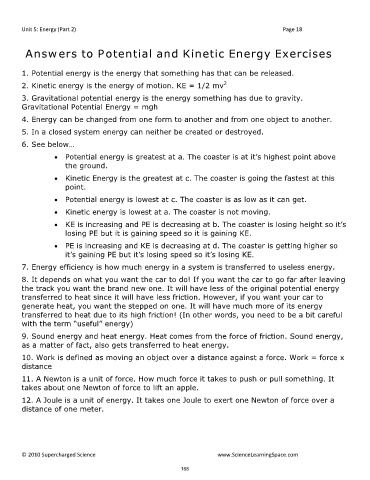Page 168 - Microsoft Word - LessonPlan-Overview.doc
P. 168
Unit 5: Energy (Part 2) Page 18
Answers to Potential and Kinetic Energy Exercises
1. Potential energy is the energy that something has that can be released.
2
2. Kinetic energy is the energy of motion. KE = 1/2 mv
3. Gravitational potential energy is the energy something has due to gravity.
Gravitational Potential Energy = mgh
4. Energy can be changed from one form to another and from one object to another.
5. In a closed system energy can neither be created or destroyed.
6. See below…
Potential energy is greatest at a. The coaster is at it’s highest point above
the ground.
Kinetic Energy is the greatest at c. The coaster is going the fastest at this
point.
Potential energy is lowest at c. The coaster is as low as it can get.
Kinetic energy is lowest at a. The coaster is not moving.
KE is increasing and PE is decreasing at b. The coaster is losing height so it’s
losing PE but it is gaining speed so it is gaining KE.
PE is increasing and KE is decreasing at d. The coaster is getting higher so
it’s gaining PE but it’s losing speed so it’s losing KE.
7. Energy efficiency is how much energy in a system is transferred to useless energy.
8. It depends on what you want the car to do! If you want the car to go far after leaving
the track you want the brand new one. It will have less of the original potential energy
transferred to heat since it will have less friction. However, if you want your car to
generate heat, you want the stepped on one. It will have much more of its energy
transferred to heat due to its high friction! (In other words, you need to be a bit careful
with the term “useful” energy)
9. Sound energy and heat energy. Heat comes from the force of friction. Sound energy,
as a matter of fact, also gets transferred to heat energy.
10. Work is defined as moving an object over a distance against a force. Work = force x
distance
11. A Newton is a unit of force. How much force it takes to push or pull something. It
takes about one Newton of force to lift an apple.
12. A Joule is a unit of energy. It takes one Joule to exert one Newton of force over a
distance of one meter.
© 2010 Supercharged Science www.ScienceLearningSpace.com
168

